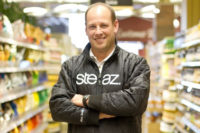
Growing up on a farm, I was used to picking vegetables from the garden, cleaning them and preparing them either for immediate use or for freezing or canning. Sometimes, immediate use entailed further preparation for my mom’s vegetable-beef soup, which took several hours to prepare until it was just right. Several layered steps produced a soup full of flavor with vegetables that retained their color, texture and fresh flavor.
However, if I don’t have half a day to dedicate to soup making, I can wander over to the local grocer and come back with a hearty, chilled StockPot soup made just the same way I make soup.
StockPot, a division of Campbell Soup, has unfair advantages compared to personal soup making. It has local farms providing fresh, pre-cut vegetables; meat, seafood and poultry producers shipping in the protein; dairies delivering milk and cream every day; and a selection of spices and herbs from all over the world. StockPot makes soup using the same layered approach restaurant chefs do.
StockPot’s new 200,000-sq.-ft. plant in Everett, WA is where its staff designs and makes soups, sauces, gravies and chiles. It also has state-of-the-art equipment to facilitate making a soup quickly and efficiently. Each recipe begins with fresh stock and an authentic mirepoix (a mixture of equal amounts of finely diced carrot, onion, and celery, often seasoned with minced herbs, and sautéed in butter). Its step-cook process is guided by proprietary batch software, so ingredients are carefully incorporated and flavors added. By slow cooking one kettle at a time, each product is made just as you would make it from scratch in your own kitchen.
Raw meat products are prepared in rooms located away from the flow; only cooked meats are allowed anywhere near the ingredient path. Modern chillers, packing systems and a Fanuc robotic palletizer help get the soup quickly packaged and out the door in Everett, WA so it’s delivered fresh to locations as far as the east coast. After a kettle of soup is cooked, much of the clean-up is automated through clean-in-place (CIP) equipment, and the software that tracks recipes, batch steps, ingredients, time and temperatures also initiates CIP.

Artist’s rendering of the StockPot main entrance shows the office area and plant behind. What it doesn’t reveal is plenty of room for expansion, should the need arise. Source: StockPot.
Restaurant roots
StockPot has its roots in the restaurant business. Founded in 1981 by Kevin Fortun who was purchasing director for Schwartz Brothers Restaurants in Bellevue, WA, StockPot set out to provide high-quality, fresh and refrigerated soups to Schwartz Brothers Restaurants in the region. Business grew rapidly, and StockPot picked up other restaurants in the area, institutional customers and eventually a national customer base including TGI Friday’s, Claim Jumper Restaurants, Sysco, grocery chains and a small gathering of international clients.StockPot was growing so fast that it entertained thoughts of moving from its initial Bellevue site to a larger site in Snohomish County’s Woodinville, WA. Before StockPot moved to Woodinville in 1999, the Campbell Soup Company acquired the business in August 1998, as part of its “Away From Home” division. Campbell’s/StockPot hired The Dennis Group to handle the Woodinville project, which provided about 100,000-sq.-ft. of space, including offices.
According to Mike Miller, vice president of manufacturing, the next six years from 1999-2005 saw incredible growth, and StockPot needed room to grow. With the help of The Dennis Group, Campbell’s/StockPot secured a location in Everett, WA (also in Snohomish County) about 20 miles to the north of Woodinville. The new facility, which more than doubled Woodinville’s space to 220,000 sq. ft. (including offices), brought along the R&D kitchen that had its beginnings in Bellevue.
According to Scott Swanson, senior manager of technical support, StockPot has seen five new buildings and 10 capacity expansions since its founding. But the single Everett site provides space to grow to the north and south, and the current building should permit a 50% capacity improvement without having to push out the walls. While StockPot moved from Woodinville, Swanson says it started production on new lines in Everett and kept production going at Woodinville, until all the equipment was moved.
R&D kitchen
The R&D kitchen is where it all starts. The kitchen has a “homey” feel; it’s industrial, but equipment and ingredients are within easy reach. The kitchen serves a couple of purposes. First, it lets StockPot chefs test recipes and determine how to scale them up for production quantities.Second, it lets StockPot chefs work together with its customers’ chefs to develop soup or sauces just the way the customer wants it. “Every restaurant chain that comes in has its signature soup, their glory soup,” says Swanson. “They come to us because they’re growing, and they want to have consistency throughout. We try to understand what makes their soup special, so there is a lot of complexity that goes into the process of matching formulas.”

Spiral discharge conveyors route soup from spiral coolers to the case packing area. Source: StockPot.
Efficient linear flow
Plant layout affords linear flow-from ingredient preparation to cooking to packaging and chilling. Swanson says a horseshoe design on the ingredient side of the plant allows for separation of uncooked ingredients such as meat and vegetables. “Our scope was not to change how we cook the soup,” says Swanson. “We didn’t want to change the product’s integrity; we wanted to improve the efficiency with which we move materials.“Our ingredients come in pre-cut for us; we don’t do the dicing. That’s not our core competency,” says Swanson. The local suppliers prepare meats, IQF herbs and fresh vegetables. Dairy products (milk and cream) are piped in from silos located adjacent to the plant. Dairy deliveries are almost daily, so the ingredients are always fresh.
There are separate rooms for thawing frozen products such as crab or lobster. There is a paste room to accommodate any ingredient arriving in a drum. Pre-weigh areas with Weightronix equipment allow accurate measurement of ingredients. Spices are measured in grams and all other ingredients in pounds.
The enormous spice room is the place where StockPot chefs put together special blends that help trademark a soup. Adjacent to the soup prep area are other rooms to support ingredient preparation; their locations were planned to facilitate increased and orderly workflow to the cooking area, the kettle pods. These rooms support functions including bulk supplies, can opening, meat cooking, pasta blanching and scullery.
Cook-to-chill
StockPot’s cook-to-chill system, combined with top-quality ingredients, provides high-quality results-soups that restaurants call their own. After the ingredients have been measured and made ready for cooking, the soups are batched and cooked in steam-jacketed kettles by Groen. When finished, soups that can be safely pumped to the packaging area are transported in an overhead piping system and immediately hot-filled into film-lined pouches, cups or bowls. Fragile soups that can not withstand pumping are transported hot via tilt kettles by Coastline to the packaging operation. When necessary, soup is stirred slowly before packaging to prevent settlement of constituent components.As soon as the packaging operation is complete, the soup is immediately cooled down through sophisticated spiral chilling systems. The significant benefit of the entire batch cooking operation is that it never boils, thereby spoiling flavor and texture. The batching operation can be timed so that, for example, vegetables sensitive to heat are added at the final stages of cooking.

Much of the cleaning is performed by totally automated CIP systems. This one cleans the dairy piping on a regular basis. Source: StockPot.
Filling and chilling
No time is wasted between the time the product is finished cooking and when it is packaged into pouches, cups and bowls. The continuous delivery of hot soup to the filling machines from Cryovac and Hinds-Bock provides immediate packaging at a safe temperature, protecting the soup from any microbe contamination. Most of the soups and sauces are filled using vertical form-fill-seal machines. A new high-speed cup filler was added to the facility to meet increased retail demands.Filled packages travel immediately to custom-designed spiral chillers that quickly cool the product to refrigerated temperatures. The chiller base and water recirculation system were designed and incorporated into the facility building shell infrastructure. Significant attention was given to construction details concerning moisture and thermal issues to provide a long service life and reduced maintenance.
After chilling, products are run through a Paxton air-knife assembly to dry the package sufficiently for applying a top label, side label and date code on the bottom. Boxes are preprinted before being filled. Krones labeling equipment was chosen for these tasks.
In addition to the case packing of filled pouches, a dedicated case packing line and robotic palletizer were installed for the new cup filler. Case packers and fillers are provided by Wexxar and JR Automation. The robot picks up the case, stacks it, builds the proper configuration and runs the finished pallet to the radial wrapper.
Soup and sauce products don’t sit around. “Most of the product goes straight to trailer and to third-party distribution,” says Swanson.

StockPot’s kettle pods provide a continuous flow of soup to the filling machines. Source: StockPot.
Cleaning up
To improve the efficiency and effectiveness of sanitation, a centralized system was installed. The new system provides bulk storage of chemicals from Ecolab as well as plant-wide distribution systems. CIP system equipment from A&B Process Systems is installed wherever practical, such as in dairy feeds and the soup feeds from kettles to fillers. The system makes use of Rathgibson piping, Murzan pumps and Tuchenhagen valves. Motors and drives are supplied by Reliance Electric and Leeson. HVAC systems incorporate sanitation modes of operation to improve humidity removal and temperature recovery of the spaces, reducing the downtime associated with sanitation periods. The CIP system goes into action at the end of a cook process. All that’s required to initiate CIP is the go-ahead when the software asks for permission to begin the cleaning process. The software keeps CIP records on times, pH, temperatures, etc. to meet regulatory requirements.The custom-designed CIP system, fashioned after pilot-scale designs at Woodinville, was implemented at Everett to automatically draw on the correct mix of water and chemicals needed for cleaning. In addition, a new automated tote-washing system was procured and installed in a centralized cleaning area adjacent to the prep and cook areas.
The site has its own wastewater treatment system that removes particulates and grease and automatically monitors pH. All the particulates are composted.
According to Swanson, StockPot cooked up its own proprietary batching software custom-tuned to its recipe and operational requirements. The batching system, which controls Rockwell PLCs and runs on StrongARM HMIs, is available at all the kettle pod locations and several other sites throughout the facility. The software is in control. For example, “If you have any conflicts, the system will advise that a step can’t be done,” says Swanson. “If you are to add an ingredient to one kettle and another kettle wants the same ingredient, the system will queue the second kettle for its ingredient addition. The system will also flag the operator so there is no cross-contamination risk.” Data collection software was provided by Wonderware.
At StockPot, the attention to detail results in a quality product. It’s easy to understand why these soups are in demand.



